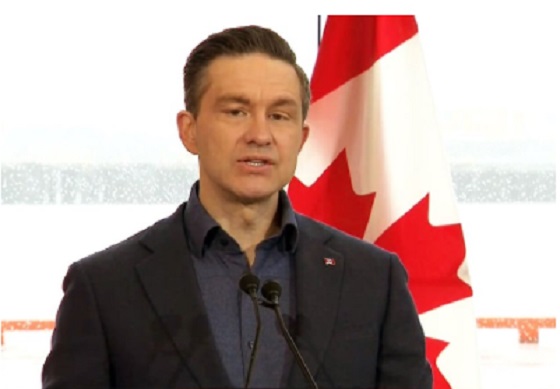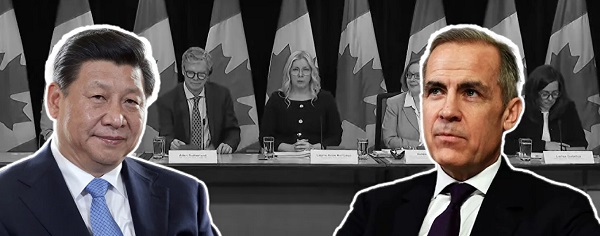Business
Trudeau leaves office with worst economic growth record in recent Canadian history

From the Fraser Institute
By Ben Eisen
In the days following Prime Minister Justin Trudeau’s resignation as leader of the Liberal Party, there has been much ink spilt about his legacy. One effusively positive review of Trudeau’s tenure claimed that his successors “will be hard-pressed to improve on his economic track record.”
But this claim is difficult to square with the historical record, which shows the economic story of the Trudeau years has been one of dismal growth. Indeed, when the growth performance of Canada’s economy is properly measured, Trudeau has the worst record of any prime minister in recent history.
There’s no single perfect measure of economic success. However, growth in inflation-adjusted per-person GDP—an indicator of living standards and incomes—remains an important and broad measure. In short, it measures how quickly the economy is growing while adjusting for inflation and population growth.
Back when he was first running for prime minister in 2015, Trudeau recognized the importance of long-term economic growth, often pointing to slow growth under his predecessor Stephen Harper. On the campaign trail, Trudeau blasted Harper for having the “worst record on economic growth since R.B. Bennett in the depths of the Great Depression.”
And growth during the Harper years was indeed slow. The Harper government endured the 2008/09 global financial crisis and subsequent weak recovery, particularly in Ontario. During Harper’s tenure as prime minister, per-person GDP growth was 0.5 per cent annually—which is lower than his predecessors Brian Mulroney (0.8 per cent) and Jean Chrétien (2.4 per cent).
So, growth was weak under Harper, but Trudeau misdiagnosed the causes. Shortly after taking office, Trudeau said looser fiscal policy—with more spending, borrowing and bigger deficits—would help spur growth in Canada (and indeed around the world).
Trudeau’s government acted on this premise, boosting spending and running deficits—but Trudeau’s approach did not move the needle on growth. In fact, things went from bad to worse. Annual per-person GDP growth under Trudeau (0.3 per cent) was even worse than under Harper.
The reasons for weak economic growth (under Harper and Trudeau) are complicated. But when it comes to performance, there’s no disputing that Trudeau’s record is worse than any long-serving prime minister in recent history. According to our recent study published by the Fraser Institute, which compared the growth performance of the five most recent long-serving prime ministers, annual per-person GDP growth was highest under Chrétien followed by Martin, Mulroney, Harper and Justin Trudeau.
Of course, some defenders will blame COVID for Trudeau’s poor economic growth record, but you can’t reasonably blame the steep but relatively short pandemic-related recession for nearly a decade of stagnation.
There’s no single perfect measure of economic performance, but per-person inflation-adjusted economic growth is an important and widely-used measure of economic success and prosperity. Despite any claims to the contrary, Justin Trudeau’s legacy on economic growth is—in historical terms—dismal. All Canadians should hope that his successor has more success and oversees faster growth in the years ahead.
Business
Trump raises China tariffs to 125%, announces 90-day pause for countries who’ve reached out to negotiate

 MxM News
MxM News
Quick Hit:
On Wednesday, President Donald Trump announced an immediate increase in tariffs on China to 125%, citing “a lack of respect” toward global markets. At the same time, he approved a 90-day pause and tariff reduction for over 75 countries that have engaged with the U.S. on trade reforms.
Key Details:
-
Trump said the dramatic tariff hike on China is meant to send a clear message: “the days of ripping off the U.S.A., and other Countries, is no longer sustainable or acceptable.”
-
The president added that over 75 countries have reached out to the U.S. Departments of Commerce, Treasury, and the U.S. Trade Representative (USTR) to negotiate on issues including trade barriers, tariffs, and currency manipulation.
-
As a goodwill measure, Trump authorized “a 90 day PAUSE, and a substantially lowered Reciprocal Tariff during this period, of 10%, also effective immediately,” noting that these countries had not retaliated against the U.S. despite strong prior warnings.
Diving Deeper:
President Donald Trump on Wednesday took a major step in reshaping the global trade landscape, announcing via Truth Social that he is raising tariffs on China to 125% effective immediately. Trump attributed the decision to “the lack of respect that China has shown to the World’s Markets,” and said it is time for Beijing to face consequences for its trade practices.
“At some point, hopefully in the near future, China will realize that the days of ripping off the U.S.A., and other Countries, is no longer sustainable or acceptable,” Trump stated.
The president emphasized that this was not a blanket policy toward all trading partners. In contrast to China, Trump said more than 75 countries have reached out to American trade officials to address ongoing issues related to tariffs and trade barriers.
“More than 75 Countries have called Representatives of the United States, including the Departments of Commerce, Treasury, and the USTR, to negotiate a solution to the subjects being discussed relative to Trade, Trade Barriers, Tariffs, Currency Manipulation, and Non Monetary Tariffs,” he wrote.
Citing those discussions and the absence of retaliation against the U.S., Trump approved a temporary reduction in reciprocal tariffs for those countries. “I have authorized a 90 day PAUSE, and a substantially lowered Reciprocal Tariff during this period, of 10%, also effective immediately.”
The move reflects a two-pronged strategy—punishing China for what Trump sees as longstanding economic abuses while rewarding countries that have shown a willingness to work with the U.S. to level the playing field.
The 125% tariff marks one of the most aggressive steps in Trump’s America First trade doctrine, likely signaling to both allies and adversaries that a second Trump administration would continue its hardline economic policies.
Alberta
Alberta takes big step towards shorter wait times and higher quality health care

From the Fraser Institute
On Monday, the Smith government announced that beginning next year it will change the way it funds surgeries in Alberta. This is a big step towards unlocking the ability of Alberta’s health-care system to provide more, better and faster services for the same or possibly fewer dollars.
To understand the significance of this change, you must understand the consequences of the current (and outdated) approach.
Currently, the Alberta government pays a lump sum of money to hospitals each year. Consequently, hospitals perceive patients as a drain on their budgets. From the hospital’s perspective, there’s little financial incentive to serve more patients, operate more efficiently and provide superior quality services.
Consider what would happen if your local grocery store received a giant bag of money each year to feed people. The number of items would quickly decline to whatever was most convenient for the store to provide. (Have a favourite cereal? Too bad.) Store hours would become less convenient for customers, alongside a general decline in overall service. This type of grocery store, like an Alberta hospital, is actually financially better off (that is, it saves money) if you go elsewhere.
The Smith government plans to flip this entire system on its head, to the benefit of patients and taxpayers. Instead of handing out bags of money each year to providers, the new system—known as “activity-based funding”—will pay health-care providers for each patient they treat, based on the patient’s particular condition and important factors that may add complexity or cost to their care.
This turns patients from a drain on budgets into a source of additional revenue. The result, as has been demonstrated in other universal health-care systems worldwide, is more services delivered using existing health-care infrastructure, lower wait times, improved quality of care, improved access to medical technologies, and less waste.
In other words, Albertans will receive far better value from their health-care system, which is currently among the most expensive in the world. And relief can’t come soon enough—for example, last year in Alberta the median wait time for orthopedic surgeries including hip and knee replacements was 66.8 weeks.
The naysayers argue this approach will undermine the province’s universal system and hurt patients. But by allowing a spectrum of providers to compete for the delivery of quality care, Alberta will follow the lead of other more successful universal health-care systems in countries such as Australia, Germany, the Netherlands and Switzerland and create greater accountability for hospitals and other health-care providers. Taxpayers will get a much better picture of what they’re paying for and how much they pay.
Again, Alberta is not exploring an untested policy. Almost every other developed country with universal health care uses some form of “activity-based funding” for hospital and surgical care. And remember, we already spend more on health care than our counterparts in nearly all of these countries yet endure longer wait times and poorer access to services generally, in part because of how we pay for surgical care.
While the devil is always in the details, and while it’s still possible for the Alberta government to get this wrong, Monday’s announcement is a big step in the right direction. A funding model that puts patients first will get Albertans more of the high-quality health care they already pay for in a timelier fashion. And provide to other provinces an example of bold health-care reform.
-

 Bruce Dowbiggin2 days ago
Bruce Dowbiggin2 days agoBettman Gives Rogers Keys To The Empire. Nothing Will Change
-

 2025 Federal Election2 days ago
2025 Federal Election2 days agoPoilievre Will Bring in ‘One and Done’ Resource Approvals, and Ten Specific Projects Including LNG Canada Phase II
-

 2025 Federal Election2 days ago
2025 Federal Election2 days agoElection Security Briefing Confirms CCP-Linked Operation Boosted Carney
-

 conflict2 days ago
conflict2 days agoZelensky Alleges Chinese Nationals Fighting for Russia, Calls for Global Response
-

 2025 Federal Election2 days ago
2025 Federal Election2 days agoHarper Endorses Poilievre at Historic Edmonton Rally: “This Crisis Was Made in Canada”
-

 John Stossel23 hours ago
John Stossel23 hours agoGovernment Gambling Hypocrisy: Bad Odds and No Competition
-

 2025 Federal Election15 hours ago
2025 Federal Election15 hours agoCommunist China helped boost Mark Carney’s image on social media, election watchdog reports
-

 2025 Federal Election1 day ago
2025 Federal Election1 day agoMark Carney’s radical left-wing, globalist record proves he is Justin Trudeau 2.0











